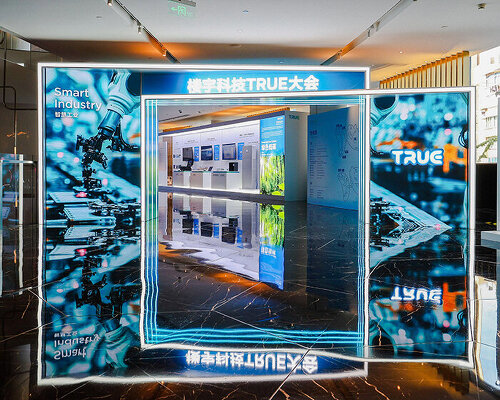TRUE Conference 2025: Redefining Smart Buildings Through AI
Humanity rarely embraces major transformations right away, often held back by fear, skepticism, or attachment to what already works. Gutenberg’s press raised fears of misinformation; urban electrification drew warnings from doctors; and office computerization sparked concerns over the devaluation of human experience. Such ruptures often provoke resistance, but they tend to open space for critical reflection and innovation. Today, with the rise of artificial intelligence and the rapid succession of technological innovations, we are living through another of these inflection points. The debate is broad, inevitable, and, as always, necessary.
At the TRUE Conference 2025, hosted by Midea Building Technologies (MBT), this discussion takes on practical and strategic dimensions by linking digital advancements with tangible goals for sustainability, efficiency, and quality of life.
The conference is establishing itself as a cultural and technical platform where technologies are presented, debated, tested, and contextualized. ArchDaily spoke with Pengyu Yang, Director of Solutions and Delivery of MBT, who is at the forefront of this shift. He shared how technological innovations are shaping the buildings of today and tomorrow.
What Makes a Building Truly Intelligent?
For Yang, an intelligent building goes beyond conventional automation: it’s about connecting equipment, data, and people in an adaptable, connected, and responsive way. Here, he distinguishes between two concepts: the difference between a “smart building” and an “intelligent building” lies in connectivity and a focus on continuous growth and experience. The latter involves full IoT connection, data collection, integration with cloud services, and adaptability over time, much like a smartphone receiving updates. In this scenario, architecture becomes a living infrastructure.
Among the many themes discussed at the TRUE Conference 2025, retrofitting stood out as a global priority. Faced with climate pressures and ambitious decarbonization goals, modernizing existing buildings becomes a viable and necessary alternative to the indiscriminate expansion of the historically polluting construction sector—especially in China, where buildings from the 1980s-2000s are aging rapidly.
Yang cites the Citigroup Tower in Shanghai as a landmark example—a large, complex building that underwent a complete retrofit focused on energy efficiency and technological updates: “We used BIM to design the workflow schedule, what time you can move some parts out and move some parts in. […] The contract required 60 days to complete, but we only used 40 days. The customer was very satisfied.”
A key element in this process was the development of custom equipment, like smaller modular magnetic bearing centrifugal chillers that could fit in elevators and be installed in buildings with spatial constraints—a crucial innovation for dense urban environments: “At many sites last year, we released the modular magnetic bearing centrifugal chiller, the size and the quantity, maybe 30% less. […] You don’t need a special tunnel to transfer the machine inside.” These solutions make modernization possible even in older and densely occupied buildings, without major structural interventions—an important contribution to reducing the environmental and operational impact of construction.
AI as a Complementary Agent, Not a Decision-Maker
Despite its potential Yang sees AI as a tool to assist, not replace, human decision-making. “AI is a very good agent for our expert engineers. […] It assists but doesn’t decide. The decision is made by an expert.”
Another major challenge is ensuring accessibility for all user profiles, including those unfamiliar with digital interfaces: “Not everyone wants or is able to use an app to turn on the air conditioning. So we created physical panels with just three buttons: on, off and mode. Simple and efficient.” These intuitive and inclusive solutions have been applied in old buildings like Shanghai’s Lilong and Beijing’s Hutong , integrating sensors and climate control without altering the original architectural structure.
Architecture as Part of a Digital Ecosystem Aimed at Efficiency
For Yang, the role of the architect must expand. Designing buildings today requires more than form—it demands understanding performance, integration, and data: “Right now, the market requires architecture, everything, not only art. You need the art, structure, mechanic, technical communication, dataset together.” Midea aims to build this ecosystem through partnerships with over 50,000 companies, enabling scalable smart solutions across regions and sectors. One of the most significant transformations noted by Yang is the company’s business model shift: they no longer sell just products, but deliver measurable outcomes:
“We are not only providing the chiller. We provide the chiller project bound with the software or service together and the promise, the result. You can test not using Midea tech.”
This performance-based model is already being implemented outside China, in countries likeVietnam, where clients pay based on efficiency delivered, requiring real integration between hardware, software, technical support, and independent auditing. Despite tech advancements, a major obstacle remains: the lack of standardized technical data, particularly for BIM and AI integration. The conference addressed this with proposals for new performance and auditing protocols, especially in critical sectors like data centers and industrial hubs: “If we have a standard, the AI can know what the chiller can do. This is important. […] We have less standards in this market.”
What emerges from Pengyu Yang’s insights and the broader spirit of the TRUE Conference is the acknowledgment that transformation is already underway—and we must adapt with sensitivity, strategy, and ethics.
The challenge is not merely adopting new technologies, but making them dialogue with social, historical, and climatic contexts. The conference reflects Midea Building Technologies’ commitment to leading green and low-carbon solutions, marking a paradigm shift in sustainable development, powered by AI and digitalization, and driven by system integration, lifecycle design, and ecosystem expansion.
Guest Feature by Eduardo Souza / ArchDaily
The post TRUE conference 2025 by midea explores how AI is transforming the future of buildings appeared first on designboom | architecture & design magazine.

